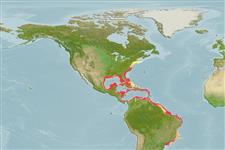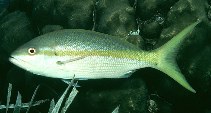Add your observation in Fish Watcher
| Native range | All suitable habitat | Point map | Year 2050 |

|
| This map was computer-generated and has not yet been reviewed. |
| Ocyurus chrysurus AquaMaps Data sources: GBIF OBIS |
Upload your photos and videos
Pictures | Videos | Sounds | Stamps, coins, misc. | Google imageOcyurus chrysurus
Picture by Randall, J.E.
Pictures | Videos | Sounds | Stamps, coins, misc. | Google imageOcyurus chrysurus
Picture by Randall, J.E.
Dominican Republic country information
Common names:
Colirrubia
Occurrence: native
Salinity: marine
Abundance: | Ref:
Importance: | Ref:
Aquaculture: | Ref:
Regulations: | Ref:
Uses: no uses
Comments:
National Checklist:
Country Information: https://www.cia.gov/library/publications/resources/the-world-factbook/geos/dr.html
National Fisheries Authority: ttp://www.cep.unep.org/rep_dom/Rep_Dom.htm#SEA-PESQUERO
Occurrences: Occurrences Point map
Main Ref: Allen, G.R., 1985
National Database:
Occurrence: native
Salinity: marine
Abundance: | Ref:
Importance: | Ref:
Aquaculture: | Ref:
Regulations: | Ref:
Uses: no uses
Comments:
National Checklist:
Country Information: https://www.cia.gov/library/publications/resources/the-world-factbook/geos/dr.html
National Fisheries Authority: ttp://www.cep.unep.org/rep_dom/Rep_Dom.htm#SEA-PESQUERO
Occurrences: Occurrences Point map
Main Ref: Allen, G.R., 1985
National Database:
Common names from other countries
Classification / Names Κοινά ονόματα | Συνώνυμα | Catalog of Fishes(Γένος, Είδη) | ITIS | CoL | WoRMS | Cloffa
> Eupercaria/misc (Various families in series Eupercaria) > Lutjanidae (Snappers) > Lutjaninae
Etymology: Ocyurus: Greek, okys = quick + Greek, oura = tail.
More on author: Bloch.
Etymology: Ocyurus: Greek, okys = quick + Greek, oura = tail.
More on author: Bloch.
Environment: milieu / climate zone / depth range / distribution range Οικολογία
Θαλασσινό(ά) Υφαλόφιλο(α); εύρος βάθους 0 - 180 m (Ref. 10795), usually 10 - 70 m (Ref. 55229). Subtropical; 42°N - 26°S, 98°W - 31°W (Ref. 55229)
Κατανομή Χώρες | Περιοχές FAO | Οικοσυστήματα | Παρουσίες | Point map | Εισαγωγές | Faunafri
Western Atlantic: extending northward to Massachusetts, USA and Bermuda and southward to southeastern Brazil, in Gulf of Mexico and Antilles (Anderson, pers. comm.). Most common in the Bahamas, off south Florida and throughout the Caribbean. Lutjanus ambiguus (Poey, 1860), an intergeneric hybrid with Lutjanus synagris (Linnaeus) as demonstrated by Loftus (1992: Ref. 33006), followed by McEachran &. Fechhelm (2005: Ref. 78464).
Length at first maturity / Μέγεθος / Βάρος / Age
Maturity: Lm 23.8, range 14 - 31 cm
Max length : 86.3 cm TL αρσενικό/απροσδιόριστο; (Ref. 9626); common length : 40.0 cm TL αρσενικό/απροσδιόριστο; (Ref. 55); μεγ. δημοσιευμένο βάρος: 4.1 kg (Ref. 40637); μεγ. αναφερόμενη ηλικία: 14 έτη (Ref. 3090)
Max length : 86.3 cm TL αρσενικό/απροσδιόριστο; (Ref. 9626); common length : 40.0 cm TL αρσενικό/απροσδιόριστο; (Ref. 55); μεγ. δημοσιευμένο βάρος: 4.1 kg (Ref. 40637); μεγ. αναφερόμενη ηλικία: 14 έτη (Ref. 3090)
Short description Κλείδες προσδιορισμού | Μορφολογία | Μορφομετρία
Ραχιαίες άκανθες (συνολικά) : 10; Μαλακές ραχιαίες ακτίνες (συνολικά) : 12 - 14; Εδρικές άκανθες: 3; Μαλακές εδρικές ακτίνες: 8 - 9. Head relatively small, lower jaw projecting slightly beyond the upper. Scale rows on back rising obliquely above lateral line. Back and upper sides blue to violet with scattered yellow spots. A prominent mid-lateral yellow band running from the snout to the caudal fin base. The lower sides and belly whitish with narrow reddish and yellow stripes; the dorsal and caudal fins yellow; the anal and pelvic fins whitish.
Adults inhabit coastal waters, mostly around coral reefs. Usually seen well above the bottom, frequently in aggregations. They feed on a combination of plankton and benthic animals including fishes, crustaceans, worms, gastropods and cephalopods, mainly at night (Ref. 9987). Young individuals are usually found over weed beds. They feed primarily on plankton (Ref. 9710). Spawning occurs throughout the year, with peaks at different times in different areas (Ref. 26938). Marketed fresh and frozen (Ref. 9987). Has been reared in captivity (Ref. 35420).
Life cycle and mating behavior Γεννητική Ωρίμανση | Αναπαραγωγή | Γεννοβολία | Αβγά | Γονιμότητα | Προνύμφες
Main reference
Upload your references | Αναφορές | Συντονιστής | Συνεργάτες
Allen, G.R., 1985. FAO Species Catalogue. Vol. 6. Snappers of the world. An annotated and illustrated catalogue of lutjanid species known to date. FAO Fish. Synop. 125(6):208 p. Rome: FAO. (Ref. 55)
IUCN Red List Status (Ref. 130435: Version 2024-2)
Data deficient (DD) ; Date assessed: 10 October 2015
Human uses
αλιεία: Εμπορικό(ά); Υδατοκαλλιέργειες: Εμπορικό(ά); αλιεία αναψυχής: ναί; Ενυδρείο: Δημόσια ενυδρεία
FAO(αλιεία: Παραγωγή; publication : search) | FishSource | Η θάλασσα γύρω μας
Περισσότερες πληροφορίες
Population dynamics
Παράμετροι Αύξησης
Max. ages / sizes
Length-weight rel.
Length-length rel.
Length-frequencies
Mass conversion
Στρατολόγηση
Αφθονία
Παράμετροι Αύξησης
Max. ages / sizes
Length-weight rel.
Length-length rel.
Length-frequencies
Mass conversion
Στρατολόγηση
Αφθονία
Life cycle
Αναπαραγωγή
Γεννητική Ωρίμανση
Γονιμότητα
Γεννοβολία
Spawning aggregations
Αβγά
Egg development
Προνύμφες
Δυναμική προνυμφών
Αναπαραγωγή
Γεννητική Ωρίμανση
Γονιμότητα
Γεννοβολία
Spawning aggregations
Αβγά
Egg development
Προνύμφες
Δυναμική προνυμφών
Physiology
Body composition
Nutrients
Κατανάλωση οξυγόνου
Κολυμβητικός τύπος
Ταχύτητα κολύμβησης
Visual pigments
Fish sound
Diseases & Parasites
Toxicity (LC50s)
Body composition
Nutrients
Κατανάλωση οξυγόνου
Κολυμβητικός τύπος
Ταχύτητα κολύμβησης
Visual pigments
Fish sound
Diseases & Parasites
Toxicity (LC50s)
Human related
Aquaculture systems
Προφίλ υδατοκαλλιεργειών
Στελέχοι
Ciguatera cases
Stamps, coins, misc.
Aquaculture systems
Προφίλ υδατοκαλλιεργειών
Στελέχοι
Ciguatera cases
Stamps, coins, misc.
Εργαλεία
Bio-Quiz | E-book | Οδηγός πεδίου | Κλείδες προσδιορισμού | Ανάλυση κατά μήκος συνθέσεων | Εργαλείο ιστορίας ζωής | Σημειακός χάρτης | Classification Tree
| Catch-MSY |
Special reports
Download XML
Διαδικτυακές πηγές
Aquatic Commons | BHL | Cloffa | Websites from users | Check FishWatcher | CISTI | Catalog of Fishes(Γένος, Είδη) | DiscoverLife | ECOTOX | Faunafri | Fishtrace | GenBank(genome, nucleotide) | GloBI | GOBASE | | Google Books | Google Scholar | Google | IGFA World Record | MitoFish | Εθνικές βάσεις δεδομένων | Otolith Atlas of Taiwan Fishes | Δημόσια ενυδρεία | PubMed | Reef Life Survey | RFE Identification | Scirus | SeaLifeBase | Δέντρο Ζωής | Wikipedia(Go, αναζήτηση) | World Records Freshwater Fishing | Zoological Record
Estimates based on models
Preferred temperature (Ref. 115969): 21.7 - 27.9, mean 25.9 (based on 650 cells).
Phylogenetic diversity index (Ref. 82804): PD50 = 1.0000 [Uniqueness, from 0.5 = low to 2.0 = high].
Bayesian length-weight: a=0.01514 (0.01348 - 0.01700), b=2.95 (2.92 - 2.98), in cm Total Length, based on LWR estimates for this species (Ref. 93245).
Τροφικό Επίπεδο (Ref. 69278): 4.0 ±0.3 se; based on diet studies.
Ελαστικότητα (Ref. 120179): Μεσαίο(α), ελάχιστος χρόνος για διπλασιασμό πληθυσμού 1,4 - 4,4 έτη (K=0.10-0.16; tm=2; tmax=14).
Prior r = 0.63, 95% CL = 0.42 - 0.95, Based on 8 data-limited stock assessments.
Fishing Vulnerability (Ref. 59153): Moderate vulnerability (38 of 100).
Climate Vulnerability (Ref. 125649): Very high vulnerability (88 of 100).




